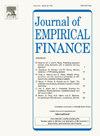蜱虫大小和公司融资决策:来自自然实验的证据
IF 2.4
2区 经济学
Q2 BUSINESS, FINANCE
引用次数: 0
摘要
利用美国证券交易委员会(SEC) 2016年Tick Size Pilot Program (TSPP)作为自然实验,我们研究了Tick Size增加对公司选择股权融资与债务融资的影响。我们发现,在该计划实施后,受tspp影响的企业发行的股票相对于债券有显著的增加。这一发现与股权融资中逆向选择的减少是一致的,因为这些公司的投资者获得了更多的基本信息。为了支持这一推论,我们表明这种增长集中在有投资者的公司中,这些公司增加了他们的信息获取。我们还发现,对于那些在实施该计划之前对股权融资中的逆向选择有较高关注程度的公司来说,这种影响更为明显。我们的研究提供了一个新颖的见解,即滴答大小的增加会影响公司的融资选择,因为滴答大小的增加会激励投资者获取更多的基本信息。本文章由计算机程序翻译,如有差异,请以英文原文为准。
Tick size and firm financing decisions: Evidence from a natural experiment
Using the SEC’s 2016 Tick Size Pilot Program (TSPP) as a natural experiment, we investigate the effects of a tick size increase on firms’ choice of equity versus debt financing. We find that after the program’s implementation, TSPP-affected firms show a significant increase in equity issuance relative to that of debt. This finding is consistent with a reduction in adverse selection in equity financing due to more acquisition of fundamental information by these firms’ investors. In support of this inference, we show that the increase is concentrated among firms with investors that increase their information acquisition. We also find that the effect is more pronounced for firms that, prior to the program, have a higher level of concern about adverse selection in equity financing. Our study offers the novel insight that a tick size increase can affect firms’ financing choices because the increased tick size generates incentives for investors to acquire more fundamental information.
求助全文
通过发布文献求助,成功后即可免费获取论文全文。
去求助
来源期刊

Journal of Empirical Finance
Multiple-
CiteScore
3.40
自引率
3.80%
发文量
59
期刊介绍:
The Journal of Empirical Finance is a financial economics journal whose aim is to publish high quality articles in empirical finance. Empirical finance is interpreted broadly to include any type of empirical work in financial economics, financial econometrics, and also theoretical work with clear empirical implications, even when there is no empirical analysis. The Journal welcomes articles in all fields of finance, such as asset pricing, corporate finance, financial econometrics, banking, international finance, microstructure, behavioural finance, etc. The Editorial Team is willing to take risks on innovative research, controversial papers, and unusual approaches. We are also particularly interested in work produced by young scholars. The composition of the editorial board reflects such goals.
 求助内容:
求助内容: 应助结果提醒方式:
应助结果提醒方式:


